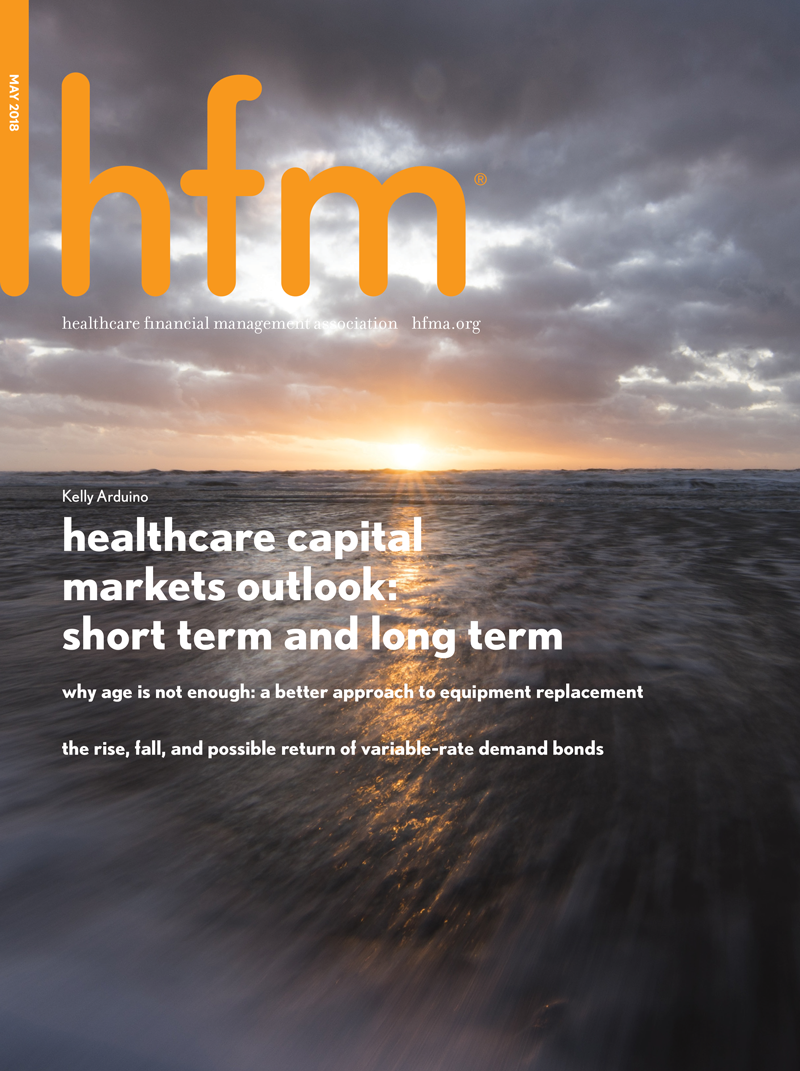
Cover Story
Emerging Value-Based Payment Trends Transforming Health Care in 2018
Hospitals and health systems plan a range of care delivery innovations in 2018 to help them reach more of the quality improvement goals of various payment models.
By Rich Daly
From the President’s Desk
|
Figure: exit rich text editor to add content |
Expanding on thoughts in his May 2018 column in hfm, HFMA President and CEO Joseph J. Fifer, FHFMA, CPA, offers perspectives on new research showing that value-based payment has yet to reduce the total cost of care. |
Video: Denials and the Revenue Cycle
David Dyke, former vice president of product management for Change Healthcare, discusses how to reduce denials that disrupt the revenue cycle and how to keep up with changing rules around claims.
Early Edition
To Succeed at Managing Population Health, Adopt a Health Plan Mindset
To be successful with population health management, healthcare provider organizations should take a lesson from the strategies health plans use to improve the quality of population-level outcomes and performance around costs.
By Allen Miller, MPH, and Carla D’Angelo, MPH
Optimizing a Health System’s Post-Acute Care Network
Health systems should develop strong networks of post-acute care providers as part of strategic efforts to deliver high-quality service across the care continuum, from wellness to end-of-life care.
By Andre Maksimow and Dawn Samaris
Value-Based Employee Compensation in an Inpatient Rehabilitation Facility
Tying employee compensation directly to performance, rather than experience, can encourage better job performance.
By Joe Ryan PT, DPT, c/NDT
Healthcare Matters
Ensuring a High-Performing Referral Network
To be able to ensure patients receive high-quality care under value-base payment arrangements, primary care physicians require well-developed specialty networks for patient referrals.
By Clive Fields, MD
Features
Why Age Is Not Enough: A Better Approach to Equipment Replacement
By considering maintenance and other costs, hospitals and health systems can work more efficiently to replace equipment.
By Lynette Jasuta and Brian Parrott
The Rise, Fall, and Possible Return of Variable-Rate Demand Bonds
Variable rate demand bonds, created in an inflationary environment, have waned in popularity but remain a viable credit source for hospitals and health systems.
By Peter W. Bruton
Health System Integration: Prescription for Success
Health systems that are pursuing a merger or acquisition require a structured planning process to achieve full integration across the merged organizations’ clinical, administrative, and operational areas.
By Brandon Klar
Creating APMs for Specialty Care: A Provider-Led Initiative for Delivering Value
The experiences of a large urology group practice can provide finance leaders with insight into key considerations involved with developing an advanced alternative payment model (APM) for a healthcare specialty area.
By Charles Saunders, MD, and Neal D. Shore, MD, FACS
Special Feature
What Is Driving Total Cost of Care?
This is a members-only preview of research that will be released at HFMA’s Annual Conference on June 24.
A recent study identifies key factors that may be influencing total cost of care in the United States and provides recommendations for addressing those factors.
By James H. Landman, JD, PhD, Keith D. Moore, MCP, and David Muhlestein, JD, PhD
Focus Area
Revenue Cycle
Revenue Cycle Software: A Practical Guide for Purchase
The purchase of new revenue cycle technology should include stakeholders from across the organization to ensure the needs of each group are met.
By Clive Chibaya
Integration
Best Practices for Affiliation Agreements Between Health Systems and Universities
A well-structured affiliation agreement between university and health system partners will enable the parties to execute joint strategic priorities and advance the shared goals of the academic medical center.
By Chris Collins, Leah Gassett, and Greg Silva
Columns
On Point
Responding to a Changing Healthcare Environment
Aligning incentives among providers and exploring telehealth opportunities are two ways in which hospitals and health systems can respond and adapt to a changing environment.
By Lia Winfield, PhD
From the Chair
Pursuing Your Passion: Advice for Healthcare Finance Leaders
Carol Friesen, FHFMA, MPH, reminisces about her experiences as 2017-18 Chair of HFMA and shares ideas and insights gleaned from her HFMA leadership journey.
By Carol A. Friesen, FHFMA, MPH
Eye on Washington
MA Ruling May Signal Industry Readiness to Integrate SDH into Traditional Medical Care
In addressing social determinants of health and social services, a recent Medicare Advantage ruling by CMS may have taken the first steps toward providing more integrated and comprehensive care to the nation’s aging population.
By Gail R. Wilensky, PhD
Business Intelligence
How Provider-Led ACOs Can Generate Long-Term Savings
Providers with concerns about the elusive success of ACOs should adopt some key strategies for implementation.
By Theresa Hush
Healthcare Innovation
The Current Outlook for Value-Based Care Under the Trump Administration
Value initiatives introduced by the Affordable Care Act have met with varied success. Under the Trump administration, the future of these initiatives is uncertain.
By Ken Perez
From the President
Value: The Way Forward
Value-based payment won’t bend the cost curve unless healthcare organizations commit to fundamental change. Not everyone will come out whole.
By Joseph J. Fifer, FHFMA, CPA
Departments
News Watch Data Analysis
Top Ambulatory Surgical Center Procedures by Volume, 2015
This bar chart shows “cataract surgery with intraocular lens insert, 1 stage” holding the highest percentage by volume of ambulatory surgical center procedures at 18.6 percent, while “carpal tunnel surgery” is at the bottom of the chart with 0.7 percent.
Supplements
HFMA Executive Roundtable
Interoperability: Driving or Impeding Value-Based Care?
Sponsored by Humana
Poor data interoperability is limiting healthcare organizations’ progress with value-based models. In this roundtable, several healthcare financial and IT leaders discuss the challenges of poor interoperability and how organizations can overcome them.
Advertising
Trendsetter
DHG Healthcare: Reimagining Cross-Continuum Relationships
This article examines how DHG Healthcare partnered with a health system to improve care coordination for hip replacements due to fracture.





